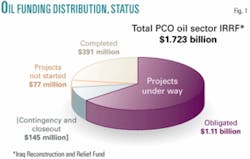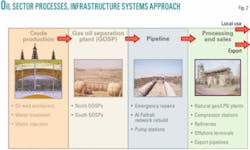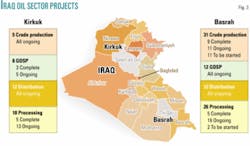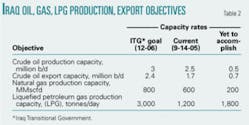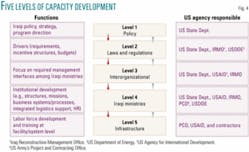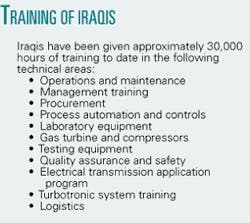The Iraqi oil industry, with the world’s second largest conventional crude oil reserves, is the most critical link to reestablishing the country as a major economy in the Persian Gulf. Currently, oil exports provide over 95% of revenue for the Iraqi government and are key to the successful funding of all ministries providing essential services to the Iraqi people.
The US has been actively involved in rehabilitation and construction of oil and gas facilities throughout Iraq since the initial Restore Iraq Oil (RIO) contract was issued to the US Army Corps of Engineers (USACE) in March 2003. Rehabilitation projects were later transferred to the US Army’s Project and Contracting Office (PCO).
As of September 2005, 22 projects in the areas of crude oil production, processing, gas-oil separation plants (GOSP), and distribution had been completed, and another 101 projects were under way. Completion of these projects, along with developing the capacity of those charged to operate and maintain them, is a critical step in building the foundation for a sustainable oil and gas industry in Iraq.
History
Many of the oil projects completed by PCO were started under the RIO contract. Other projects were added for numerous Iraqi governmental ministries and were funded with the $18.4 billion Iraq Reconstruction and Relief Fund (IRRF) issued by the US Congress in 2004.
A total of $1.89 billion, roughly 10% of the total appropriation, was earmarked for projects in the oil sector. Several adjustments have been made since that time, and the current oil sector budget is $1.72 billion. This amount of funding is by no means insignificant; however, it is not sufficient to provide repairs and upgrades to all the oil and gas facilities in the country.
Iraq’s Coalition Provisional Authority estimated in 2004 that completion of all the repairs and upgrades to oil sector facilities would require $8 billion. Fig. 1 illustrates the current distribution of the oil sector appropriation.
Alongside the issuance of the IRRF was the National Security Presidential Directive (NSPD) 36, which assigned responsibilities to the various US governmental agencies involved with Iraq reconstruction.
Under the NSPD, the Iraq Reconstruction Management Office (IRMO) was created as a temporary office within the US Department of State to provide strategic and programmatic direction to the entire US-funded reconstruction program. PCO was also created as a temporary agency to execute infrastructure rehabilitation and construction.
PCO has reported directly to IRMO and has worked closely with other US government executing agencies such as US Agency for International Development (USAID) and the USACE’s Gulf Region Division (GRD). GRD and PCO consolidated into GRD/PCO Dec. 4.
PCO conducts work through a series of major contracts targeted toward four distinct sectors. The oil sector is one of the critical sectors, as are the electricity sector and the public works and water sector. The fourth sector, facilities and transportation, includes communications, health care facilities, and security and justice facilities.
More than 3,000 separate projects have been defined within these sectors, some of which are small rehabilitations and some, major infrastructure construction projects. There are presently 136 projects defined in the oil sector. The priorities and exact number of projects change somewhat over time, due to factors such as changing conditions on the ground.
PCO has two design-build contractors in the oil sector: Kellogg, Brown & Root Inc. and Parsons Iraq Joint Venture. These contractors provide the actual execution of work for oil and gas reconstruction, and they use Iraqi subcontractors and staff extensively.
PCO also has an oil sector contractor, Foster Wheeler Ltd., which provides oversight of the design-build contractors and helps to build capacity within Iraq’s Ministry of Oil. Roughly 4,600 Iraqis currently are working side-by-side with PCO contractors to rebuild the oil industry.
Project prioritization
Prioritization of projects executed through the design-build contractors stems from both the initial projects started and transferred under the RIO contract and continued strategic assessments conducted by IRMO in consultation with the Ministry of Oil.
The potential for return on investment has been one of the key factors for prioritization. Generally, each $1 invested in the oil infrastructure is expected to yield a $5 recurring annual return. Therefore, efforts have been focused on the reconstruction or refurbishment of facilities in two locations of oil production: Kirkuk in northern Iraq, and Basrah in the south.
The four general categories of work performed at these locations are crude oil production, GOSPs, pipelines, and processing and sales (Fig. 2).
Completion of construction and rehabilitation of these facilities will increase capacity for local use and add revenue from oil exports. The oil production to support in-country fuel requirements and for export revenue is essential for supporting the new government of Iraq and for funding other key ministries that do not yet have established revenue sources.
In the long term, the Iraqi government may decide that other ministries should provide for their own sustainability, possibly through fee-for-service. This process, however, will have to be phased in before reliable revenue generated from other state-owned enterprises are realized.
Along with providing a constant revenue stream to the Iraqi government, oil and gas fuel electric power generation facilities, which in turn support oil, water, telecommunications, and other essential services in Iraq. The country’s entire infrastructure is dependent upon the constant and sustainable production of oil.
Construction update
Efforts have been concentrated on engineering, procurement, and construction. PCO has only 13 additional projects to be started, and all projects are scheduled for completion by yearend 2006. Table 1 shows the number of major rehabilitation projects completed, under way, and yet to be started by PCO.
Fig.3 shows the types and general locations of oil sector projects undertaken by PCO.
null
The Iraq Transitional Government’s (ITG) goal is to rehabilitate existing oil and gas facilities to achieve a crude oil production rate of 3 million b/d (Table 2).
Reconstruction impact
The reconstruction effort is having a clear impact on the Iraq oil and gas industry’s capabilities. The following are ongoing or completed projects that exemplify reconstruction progress:
• The Qarmat Ali water injection system and treatment plant project in southern Iraq increased water injection capability substantially, which helped reverse the decline in oil production from southern Iraq’s Rumaila field. That work is 70% complete, and the next phase of work will increase injection capacity to 100% of goal, boosting oil production by as much as 200,000 b/d.
• The Baba field wet crude oil treatment project in northern Iraq will increase the amount of available dewatered oil by 80,000 b/d.
Other wet oil separation plants also have increased capacity:
- The Saralu GOSP in northern Iraq provides a net increase of 70,000 b/d of dewatered oil to Iraq’s output.
- Bai HassanNorth oil field in northern Iraq provides a net increase of 70,000 b/d of dewatered oil.
- Bai HassanSouth provides a net increase of 60,000 b/d of dewatered oil.
• The rehabilitation and construction of GOSP projects, compressor stations, and natural gas liquids and liquefied petroleum gas (LPG) plant facilities will increase gas production capacity by 300 MMscfd in the north and 350 MMscfd in the south.
• Further GOSP restoration will increase oil capacity by 220,000 b/d.
• Oil well workovers in the south will increase production capacity by 300,000 b/d.
• Pipeline reconstruction projects will increase operation reliability and boost capacity by up to 500,000 b/d.
• Increased LPG production in the north and south will make Iraq self-sufficient in LPG for the first time since the war. LPG is the most widely used fuel for cooking in Iraq.
• Rebuilding key compressor stations will aid in the recovery of flared gas and LPG.
• A security lighting project has been completed to help protect northern gas facilities from insurgent attacks.
• Operational reliability has been improved with the overhaul of key equipment, labs, and oil export projects, including the restoration of all remaining loading arms and spare parts.
• The completion of the offshore oil export platform metering project will provide improved accuracy and accountability required by worldwide pressure, the International Monetary Fund, and the World Bank.
Sustainability and CD
The US’s success in rebuilding the infrastructure in Iraq will be measured in terms of whether the completed facilities function and produce the services as planned over the long term. PCO, in cooperation with IRMO and other US agencies, began working toward the sustainability of these facilities over a year ago through a process called Capacity Development (CD). CD is one of the basic tools being used to transfer knowledge, skills, and abilities to the Iraqi workers at the various infrastructure facilities.
Through the Iraq Capacity Development PCO Management and Interface Plan (CD plan), PCO guides the work of its contractors and defines the roles and responsibilities of various organizations involved in the reconstruction.
The CD process has been defined in the CD plan by five distinct elements that range from the top level of governmental structure to the training of individuals at plants on how to maintain and operate new pieces of equipment.
Infrastructure sustainability is dependent both on a functioning facility and on the functioning of all five levels as they apply to Iraq reconstruction (Fig. 4).
Infrastructure
Level 5. PCO and its contractors primarily are involved with CD at the infrastructure level. This is where facility workers are trained on new equipment and systems at their facilities. In addition to extensive on-the-job training, CD deliverables at the facility include operations and maintenance (O&M) training, preventive maintenance training, and written translations of training materials and manuals.
Iraqi ministries
Level 4. The US’s work on oil sector facilities has been limited to rehabilitation, repair, and expansion of existing facilities. The Ministry of Oil contains highly qualified professional staff that have managed and operated these facilities for years, so they are already knowledgeable. This makes the CD work to bring ministry staff up to speed at the infrastructure level much easier than if totally new facilities were being constructed. Although CD work may be easier, it is nonetheless considered a critical and necessary component to the successful completion of all facility rehabilitation or repair.
PCO also conducts some activities at Level 4, the level at which ministry staff is trained and provided with new business and administration systems necessary for plant operation. These efforts are complementary to the ongoing work by IRMO and USAID with the ministries.
Oil sector CD efforts at the Iraqi ministry level are focused on developing systems required to strengthen and support an efficient, sustainable industry, including business management, procurement, finance, warehousing, and human resources. These are some of the primary CD needs identified by ministry staff as key to asset management.
Training, deliverables
Levels 4 and 5. Training and deliverables also fall under the auspices of Levels 4 and 5 of the CD program. To date, PCO contractors have conducted over 300,000 hr of training for Iraqis in the oil sector. Some of the specific activities that PCO contractors are performing at the facility and ministry headquarters levels include:
• Formal classroom and offsite training sessions (see box).
• Daily on-the-job training sessions.
• Regular meetings with facility and ministry staff concerning daily work and planning.
• Provision and review of O&M manuals and preventive maintenance manuals delivered and translated into Arabic and Kurdish.
• Operations testing and commissioning.
• Provision of spare parts and spare parts lists.
• Special training sessions for Iraqi women-owned businesses interested in subcontracting.
Although training is conducted mainly through in-country, on-the-job training, specialty training sessions also are being conducted in locations outside of Iraq, including the US, Kuwait, Jordan, the UAE, Switzerland, France, Germany, and Turkey.
As a management tool, PCO developed a unique web-based database that is being used by each of the PCO contractors to record its CD activities at Levels 4 and 5 on a monthly basis.
The database tracks information, such as subcontracting to Iraqi firms, Iraqi employment, training sessions, the participation of Iraqi woman, provision of deliverables such as O&M manuals and preventive maintenance manuals, and transition to Iraqi ministries.
Policy and laws
Levels 1, 2, and 3. CD Levels 1, 2, and 3, beyond PCO’s responsibility, involve activities that are longer-term in nature, including development of policy, laws, and regulations and coordination among ministries and other stakeholders. They are necessary for the successful and sustainable operation of new or reconstructed infrastructure.
For example, at Level 3, coordination among the ministries will be essential in developing a national fuel strategy. At Levels 1 and 2, policies, laws, and regulations could be pursued to encourage a rationalization of the fuel price subsidies. US policy for developing CD initiatives for these levels falls under the purview of the US State Department and IRMO.
The US, under IRMO’s leadership, recently established a Capacity Development Sector Working Group (CDWG) to help develop capacity at all five CD levels for several of the key ministries, including the Ministry of Oil. The GRD/PCO deputy director for reconstruction chairs the CDWG. Iraqi ministry representatives, together with key US organizations, other coalition countries, and several donor organizations involved in Iraq reconstruction, are represented.
Challenges
Work is progressing toward the goals, but there is much more to be done. Specific challenges include the following:
System deterioration. The former Iraqi government of the past 30 years did not place a priority on O&M, safety, and other good operational practices. The result is a series of deteriorated systems throughout the country. Looting directly following the war caused additional damage to the already strained infrastructure.
Work beyond the IRRF will be necessary to rehabilitate many of these systems, which remain fragile and weak. An additional investment of about $2 billion would be required to fully rehabilitate the existing infrastructure. If this could be accomplished, the result would be a much more robust oil infrastructure with the capacity to provide a significant incremental volume of crude oil for export sales.
Capacity development. The sustainability of plants and systems is an objective that must be met, both immediately after the completion of construction or rehabilitation and over the long term. PCO, other US government parties involved in reconstruction, and other donor nations are using CD as a primary means to facilitate conditions for helping the Iraqis operate these systems as intended.
As a temporary organization, PCO is providing the building blocks at CD Levels 4 and 5 necessary to support a sustainable infrastructure. PCO currently is addressing several CD challenges. One example is assisting the Iraqis in overcoming a substandard preventive maintenance culture that began under the previous regime. US organizations are working hand-in-hand with Iraqis to develop a solid maintenance system for each project handed over to the Iraqis.
Insurgent attacks. The Ministry of Oil has a long and successful record in oil and gas production, to the extent that it has become the mainstay of the country’s economy. This dependency makes the Iraq economy vulnerable to attacks on its oil industry facilities.
This potential “single point of failure” for the economy requires diligent application of Iraqi security and military forces as necessary to protect the production, processing, and distribution systems from further attacks by insurgents. The threat of insurgent attacks on the physical equipment and workers is a challenge that is being met through increased security and field activities by the Iraqi military, supplemented by coalition forces.
Political transition. Rapid progress is being made toward achieving a new, stable government in Iraq; however, the US and its coalition partners have been working with an interim government to this point. Key Ministry of Oil staff could change following the Dec. 15 national elections.
This uncertainty has presented an ongoing challenge for all parties, including the Iraqis. PCO expects that the stability of Iraq’s government will increase significantly over the next several months as Iraq forms a permanent government after the December elections.
2006 priorities
The oil sector’s mission is very clear for the near future. PCO must complete the remaining projects and take the steps necessary to ensure that facilities are set to run smoothly after handover.
“The next year will bring PCO very close to the conclusion of its construction mission,” said Kathye Johnson, GRD/PCO deputy director in Baghdad. “We will be handing over some of the more complex projects this year, and we will be working closely with the Iraqis to make sure they are prepared to operate and maintain the facilities.”
Key activities for the year ahead include the following:
Complete the work. PCO must press ahead with the challenge of completing the construction and rehabilitation of oil facilities in a very hostile environment. The completion of ongoing projects will increase the Iraqi crude production capacity over the prewar production rate of 2.6 million b/d and set Iraq on a path to meet its goal of 3 million b/d. This will provide for the physical facilities for the Iraq government to meet the needs of the Iraqi citizens and to create a much needed revenue source through crude oil exports.
Increase Ministry of Oil capabilities. The US will provide strong support to the Ministry of Oil over the next year, with the understanding that some goals for strengthening the ministries can be achieved relatively quickly, and others will require several years to accomplish.
The US State Department contracted the US Trade and Development Agency to provide technical, management, and human resource development to the Ministry of Oil as part of the Iraq oil training program. The program is meant to address immediate training needs within the ministry with a focus on providing a road map for longer-term training that the ministry could institute and carry out.
International oil and gas companies are performing this work to assist the Ministry of Oil in increasing its capabilities. About 30 private-sector companies have signed memorandums of understanding with Iraq to provide activities such as training, consulting, and reservoirs studies. The companies often perform this work at no cost as a way to develop relationships and to participate initially in Iraq’s growing oil and gas industries. More information on this participation can be found at US Department of Energy, www.eia.doe.gov/emeu/cabs/iraq.html.
Improve O&M strategy and business practice. The O&M philosophy within the Iraqi infrastructure has deteriorated significantly during the past 30 years, and this has hurt the ability of Iraq’s oil and gas industry to optimize its operations. The O&M strategy can be implemented successfully at the infrastructure level (i.e., CD Level 5) only if the superstructure is in place to support the improved O&M and plant operations over the long term. Planning and prevention are keys to sustained operations, and these activities require investment.
Create an energy plan. A well-developed energy plan is critical to the sustainability of all essential services in Iraq. Key US agencies are working with the Ministry of Oil, Ministry of Electricity, and others to ensure a coordinated and strategic approach to developing a long-term energy plan. This plan will address issues such as oil and gas import and export strategies, foreign direct investment options, and coordination mechanisms to ensure adequate provision of fuels to meet a variety of needs.
Improve infrastructure security. Over the past several months, PCO has been moving toward a greater reliance on Iraqi and other Middle East firms to perform the reconstruction work, and that trend will continue throughout the duration of the mission. In terms of safety risks and security costs, the advantages of having local firms complete the reconstruction work are clear. The benefits also can be measured by the more-rapid completion of projects and the increase in Iraqi employment.
The Iraq infrastructure will operate as intended only to the degree that the Iraqi security forces are able to overcome the insurgency and reduce the threat to normal operations. It may take several years for the threat to diminish significantly, but the sooner the Iraqi forces can begin to take on this task independently, the sooner improvements will be realized.
Develop people and processes. The Iraqi people are willing and, in many cases, ready to take on the responsibility for maintaining their infrastructure. The Ministry of Oil staff and the staff of the state-owned oil companies are no exception. PCO will continue to work with Iraqi workers assigned at the infrastructure level to ensure that they understand clearly their role in keeping the facilities running. PCO also will interface with other US organizations responsible for setting up superstructure to support the facility-level activities.
The future
Oil is the most abundant natural resource in Iraq and the mainstay of the Iraqi economy. Oil infrastructure restoration is unique in that it is the only sector in which every dollar invested, either directly or indirectly, provides substantial revenue to Iraq for future reconstruction and for the provision of essential services.
The extent of change in this county is dramatic by any standard. Reconstruction is being completed concurrent with the formation of a new government structure in Iraq and the adoption of a new constitution. The fact that all these changes must occur simultaneously, rather than sequentially, compounds the difficulty, and the accomplishment of each requires innovation and simplification wherever possible.
The challenge of rebuilding and developing the infrastructure in this environment is being met with enthusiasm on the part of the Iraqis. The US and its contractors are dedicated to working hand-in-hand with the Iraqis to lay the foundation necessary for the oil industry to reach its potential and to provide a long-term stable environment for the Iraqi people. ✦
The authors
Merriam Mashatt is director of strategic communications for the US Department of Army’s Iraq Project and Contracting Office in Washington, DC (PCO-W). She has worked on Iraq reconstruction efforts since 2003. Prior to this position, she served as PCO-W’s director of capacity development and as director of private sector development for the Washington office of the Iraq Coalition Provisional Authority. Mashatt, an economist, previously worked in the field of international trade in both the private and public sectors. Prior to joining the US Department of Defense, she managed a trade policy office at the US Department of Commerce, whose mission was to open foreign markets to US exports and enforce US trade laws. Mashatt is an Iraqi-American and has an MA in foreign affairs from the University of Virginia.
Sheryl Lewis currently is the director of capacity development for the Iraq PCO-W, Department of Army. Prior to this position, she served as the PCO-W capacity development program manager. She also served as the private sector development assistant in Washington, DC, and as the Governance Office assistant in Baghdad, Iraq, for the Coalition Provisional Authority. Lewis has an MA in international commerce and policy from George Mason University.
